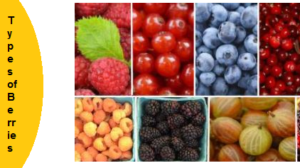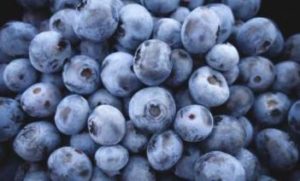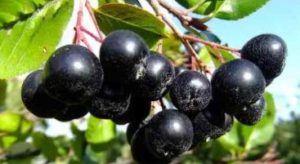
A Berries tend to have a good nutritional profile. They’re typically high in fiber, vitamin C, and antioxidant polyphenols.
As a result, incorporating berries into your diet may help prevent and reduce symptoms of many chronic diseases.
But just what is a berry? We usually think of a berry as any type of small edible fruit. Actually, by definition in botanical terms, a berry is “a simple fruit with seeds and pulp produced from a single ovary of a single flower.” This means that botanically, grapes, cucumbers, tomatoes, oranges, watermelons, pumpkins, and even bananas can be also classed as berries.
Types of Berries (With Picture and Common Name)
Let’s look in more detail at some of the most popular types of berries you should try to include in your diet.
Cranberries

Cranberries are a sour-tasting type of red berry that are rich in vitamin C and are packed with fiber and antioxidants.
In the wild, cranberries grow on vines near ground level in bogs. Cranberry fruits are used to produce juice, jams, and are also sold as dried berries. Because cranberries have a very tart taste, cranberry products often contain added sugar.
Being a red berry, cranberries are rich in antioxidants such as flavanones, anthocyanins, and flavanols.
One of the most common uses of consuming cranberry juice is to help prevent urinary tract infections. It seems that cranberries have a mild antibacterial effect and may help to address issues with the urinary system.
Blueberry

Blueberries are usually top on the list of dark-colored berries because of their juicy flesh and sweet taste.
One cup (148 grams) of blueberries provides the following nutrients
- Calories:
84 - Fiber:
3.6 grams - Vitamin
C: 16% of the DV - Vitamin
K: 24% of the DV - Manganese:
22% of the DV
As with most dark berries such as blackberries, blueberries contain a lot of vitamins and antioxidants. Studies have shown that anthocyanins (the pigment that gives berries its color) in blueberries help promote good eye health. Blueberries are also low in fat and high in fiber as well as vitamins C and K.
Studies have also shown that dark berry fruits such as blueberries and blackberries have a good effect on cardiovascular health. One of the reasons why eating blueberries is good for you is that they help lower cholesterol.
Huckleberry

You could easily mistake huckleberries for blueberries as they look very similar. In fact, in some countries, they are called the European blueberry and are also referred to as bilberries.
Huckleberries are a type of wild berry that is rarely cultivated.
The notable difference between blueberries and huckleberries is the seeds. Compared to blueberries, huckleberries also have less sugar and, therefore, fewer carbs. However, just like most types of dark berries, huckleberries are rich in fiber and antioxidants.
You can use huckleberries in your diet in place of blueberries if you are looking to reduce your carb intake.
Chokeberries

Chokeberry (Aronia berry) is a type of sour berry that looks similar to blueberries but have a darker, almost black color.
The reason why chokeberries are one of the bitter-tasting berries is due to their high levels of tannins. Eating a few of these dark types of berries can leave your mouth feeling dry and bitter.
Because of their astringent taste, most people don’t eat fresh chokeberries. Rather, they use them to make jams, teas, syrups or put into baked goods.
Although chokeberries are a type of black-colored berry, you can also get red chokeberries.
According to some studies, chokeberries could be one of the healthiest berries for improving cardiovascular health. The antioxidants in these dark berries help reduce inflammation, blood pressure, and cholesterol.
If you find chokeberries too bitter to eat, then you can buy chokeberry extracts in the form of powder.
Elderberry

Elderberry is another berry on the list of dark berries that are healthy for you. However, unlike many of the other healthy berries, these tiny black fruits shouldn’t be eaten raw.
Elderberries may be among some of the healthiest berries to consume. Elderberries are rich in vitamins C and A and are a good source of healthy minerals.
To incorporate these small dark berries into your diet, you can make elderberry tea or syrup. In fact, there is some evidence that elderberry syrup can help treat colds and other upper respiratory infections.
Similar to the health benefits of other dark berries, the anthocyanins in elderberry are good for your heart health and can help boost your immune system.
Gooseberry
Gooseberries are a type of sour berry that grows on small bushes and are usually a green type of berry.
Even though gooseberries may be among the sourest berries you can eat, they are still not as sharp and tangy as lemons. There are also varieties of gooseberry bushes that produce red, purple, yellow, and white berry fruits.
Some types of gooseberry (botanically a currant) have been crossed with black currants to produce a dark berry called jostaberries.
As with most edible berries, gooseberries contain fiber, vitamins, and other nutrients. Various gooseberry cultivars are also a good source of antioxidants, although darker varieties of gooseberries typically have higher levels of anthocyanins.
Lingonberry
Another type of red berry is the lingonberry which has a bitter taste and grows on small bushes.
Because of their tart taste, these small red berries are often used to make jams, syrups, compotes, or added to smoothies. Their rich vitamin C content and trace minerals can help to improve the nutritional content of many foods.
To enjoy its health benefits, you should consume fresh lingonberries rather than powdered supplements. Studies have shown that the fiber content in lingonberries helps prevent blood sugar spikes. However, lingonberry supplements didn’t have the same positive effect.
Boysenberries
A hybrid berry called the boysenberry is a cross between a loganberry, blackberry, raspberry, and dewberry.
Boysenberries are a type of dark red or maroon berry that looks similar in shape to a blackberry. Although these red berry fruits don’t have as many vitamins as blackberries, they have just as much fiber. Boysenberries also contain many important nutrients, vitamins minerals.
Studies indicate that eating these soft juicy red berries may help to lower blood pressure and help prevent fat absorption in the gastrointestinal tract.
Red Currants and Black Currants
Red currants are a type of vibrant red berry which grows in clusters like grapes.
Redcurrants are similar in size to blueberries and these shiny red berries have a tart, tangy taste that still has some sweetness. The astringent taste of these currant varieties can leave your mouth feeling somewhat dry, although not as dry and bitter as chokeberries.
Being a good source of antioxidants, red currants are extremely good for your health. However, studies have shown that black currants contain significantly higher levels of anthocyanins than redcurrants.
Delicious Fruits We Think of as Berries
Let’s look in more detail at some delicious small soft fruits that we use as berries in the culinary world, but are actually not true berries botanically. These berry-type fruits are called aggregate fruits because they grow from a single flower when several ovaries merge together.
Strawberries
Fresh varieties of strawberries are some of the most popular types of summer fruits in the world. Strawberries can also grow to become some of the largest types of berries you can buy.
Strawberries are an aggregate fruit that are usually red in color. However, there is a type of white strawberry called a pineberry that you can read about later in the article.
Most of the benefits of eating red fruits such as strawberries come from the high levels of vitamin C. For example, 5 medium-sized strawberries can provide you with 60% of your vitamin C daily requirements.
Strawberries are delicious berry fruits to eat whole as a dessert. They are also delicious berries in to put in smoothies, make into jam, or just blend and pour over desserts.
Although not classed as a type of true berry, some people put strawberries on the list of superfoods. Eating strawberries is good for lowering inflammation, blood pressure, and improving cardiovascular health.
Blackberry
Although not a true berry, for many people blackberries are one of the tastiest berry fruits that they can eat.
What is it that makes this dark-purple berry a super fruit? Similar to blueberries, blackberries are an amazing source of healthy antioxidants and vitamins. Blackberries contain a number of phenolic compounds and are rich in fiber and vitamin C.
The best blackberries to eat are ones you pick in the wild. As with most black and purple berries, eating blackberries has a positive impact on your cardiovascular health. In fact, compared to berries such as blueberries, cranberries, and red raspberries, blackberries are one of the healthiest berries you can eat.
Red, Black, Golden and White Raspberry
Raspberries are another berry-type of fruit that many people class as a super fruit with amazing health benefits.
One cup (123 grams) of raspberries provides :
- Calories:
64 - Fiber:
8 grams - Vitamin
C: 36% of the DV - Vitamin
K: 8% of the DV - Manganese:
Red raspberries are popular summer berries that are packed full as vitamin C. In fact, from all the fruits on the list of healthy berries, raspberries come out top in terms of dietary fiber.
Consuming red raspberries has been linked to reducing the risk of developing chronic diseases such as cancer, heart disease, and type 2 diabetes. You can find more details in my article about the scientifically proven health benefits of raspberries.
Did you know that there are other types of raspberries which may be even healthier for you than the red varieties?
Black raspberries
Black raspberries may look like blackberries but they are in fact a black variety of raspberry. As you would expect from a black type of berry, they are rich in anthocyanins. Studies have shown that black raspberries varieties are good for lowering inflammation and cholesterol. They have even been linked to cancer prevention.
Golden raspberries
Golden raspberries are an unusual type of golden berry with many health benefits. Scientists describe this kind of raspberry as a yellow raspberry with “super antioxidant” activities.
White raspberries
One rare type of raspberry is a variety of white raspberry. Although there technically isn’t a botanical variety of raspberry that is completely white, some yellow raspberry varieties may be so pale that they appear almost white.
Olallieberry
A hybrid fruit called an olallieberry is a dark type of berry that looks like a plump blackberry or black raspberry.
Being a variety of black berry-like fruit, olallieberries probably are high in anthocyanins. However, there is no information on its nutritional content.
Mulberry
Mulberries are berries that look like long raspberries or blackberries and come in a variety of colors. Mulberry varieties come in black, purple, red, and even white types of berries.
Mulberries are a fairly sweet berry-type fruit that have a slightly astringent and tart taste. You can eat mulberries fresh, or you can use them in recipes as you would use blackberries or raspberries.
Because mulberries are very fragile summer fruits, it is difficult to buy them fresh. You can buy these types of berries frozen or you can grow a mulberry tree in your garden.
The healthy nutrients in these berry fruits have been linked to improving cardiovascular health, helping to manage type 2 diabetes, and helping to prevent obesity.
Types of Exotic Berries
Let’s look at varieties of exotic berries, many of which are rightly on the list of berries that are classed as superfoods.
Açai Berries
Açai berries are small black-purple berries that look like a grape and grow on the açai palm tree.
Although it is difficult to buy these super berries fresh, açai berries are becoming more popular due to their fantastic health benefits. One of the most common ways of benefiting from this dark berry is to buy it in powder form.
Studies have shown that açai black berry powder has very high levels of polyphenols and other antioxidants.
Goji Berries
Goji berries (wolfberries) are a red type of exotic berry that are better known in Western countries than açai berries.
Goji berries are among the types of berries that are classed as superfoods. It is difficult to buy fresh goji berries and they are usually sold as red dried berries. Just an ounce (28 g) of these super berries gives you half of your daily vitamin A needs and 10% of your fiber requirements.
Because goji berries are usually sold dried, they have a very sweet taste with a slight bitterness. Some people use goji berries in baked goods to cut down on sugar and increase nutritional value.
Researchers have found that the high levels of antioxidants, such as in goji berries, can help to slow down aging, boost immunity, and improve blood health
Physalis (Cape Gooseberry)
Physalis is an orange type of berry that belongs to fruits in the nightshade family. Physalis berries are also called groundcherries, golden berries, or Cape gooseberries.
Physalis berries are low in fat and high in fiber. The health benefits of these golden berries are quite impressive due to their antioxidant content. They can help to reduce inflammation, strengthen your immune system, and they have nutrients that are good for vision.
These orange berry fruits have a sweet taste that some people say is similar to tropical fruits such as mangoes or pineapples. You can eat these orange berries raw or you can chop them up in a smoothie or add to a savory salad for some sweetness.